Discover the ultimate guide to selecting the perfect ski jacket – from staying warm in winter wonderlands to mastering the art of slope-to-style sophistication!

As winter enthusiasts gear up for another season on the slopes, the importance of choosing the right ski jacket cannot be overstated. Whether you're a seasoned pro or a first-time skier, your jacket plays a pivotal role in keeping you warm, dry, and comfortable in the unforgiving mountain environment.
Beyond mere aesthetics, it's a vital piece of equipment that can make or break your ski experience. In this comprehensive guide, we'll delve into the critical factors to consider when selecting the perfect ski jacket, helping you navigate the sea of options to find the ideal blend of performance, style, and functionality.
From waterproof ratings to insulation types, from fit to ventilation, we've got you covered so you can make an informed choice and hit the slopes with confidence.
Recommended: The Best Ski Jackets For Men And Women
Waterproofing and Breathability

Waterproofing and breathability are two of the most crucial factors to consider when choosing a ski jacket, as they directly impact your comfort and protection while skiing in various weather conditions.
Waterproofing:
When it comes to waterproofing, ski jackets are often rated using a measurement in millimeters (mm) that indicates how much water pressure the fabric can withstand before it starts to leak. The higher the waterproof rating, the more resistant the jacket is to moisture. For most ski jackets, a rating of 10,000mm to 20,000mm or more is considered suitable for skiing in wet or snowy conditions. If you frequently ski in heavy, wet snow or rainy weather, it's a good idea to opt for a higher waterproof rating.
In addition to the waterproof fabric, the jacket's zippers, seams, and pockets should also be designed to prevent water from entering. Look for jackets with sealed or taped seams to ensure that moisture doesn't seep through the stitching. Water-resistant zippers and storm flaps over the main zipper can further enhance the jacket's waterproofing capabilities.
Breathability:
Breathability is equally important because it determines how well the jacket allows moisture (in the form of sweat) to escape from the inside, preventing you from feeling clammy and sweaty during physical activity. Skiing can be a high-intensity sport, and you'll generate heat and moisture, even in cold conditions.
Breathability is also measured using a rating, typically in grams, such as 10,000g or 20,000g. A higher rating indicates better breathability. A breathable jacket will help regulate your body temperature and keep you comfortable. Look for ski jackets with built-in ventilation features like zippered underarm vents or mesh-lined pockets that can be opened to release excess heat and moisture when needed.
The ideal balance between waterproofing and breathability will depend on your skiing style and the climate you typically encounter. If you ski in cold, dry conditions, you might prioritize warmth and waterproofing. On the other hand, if you ski in milder, spring-like conditions or engage in high-intensity skiing, breathability becomes more critical to prevent overheating.
Ultimately, finding a ski jacket with the right combination of waterproofing and breathability ensures you stay dry from external moisture while allowing internal moisture to escape, creating a comfortable and enjoyable skiing experience, no matter the weather.
Insulation
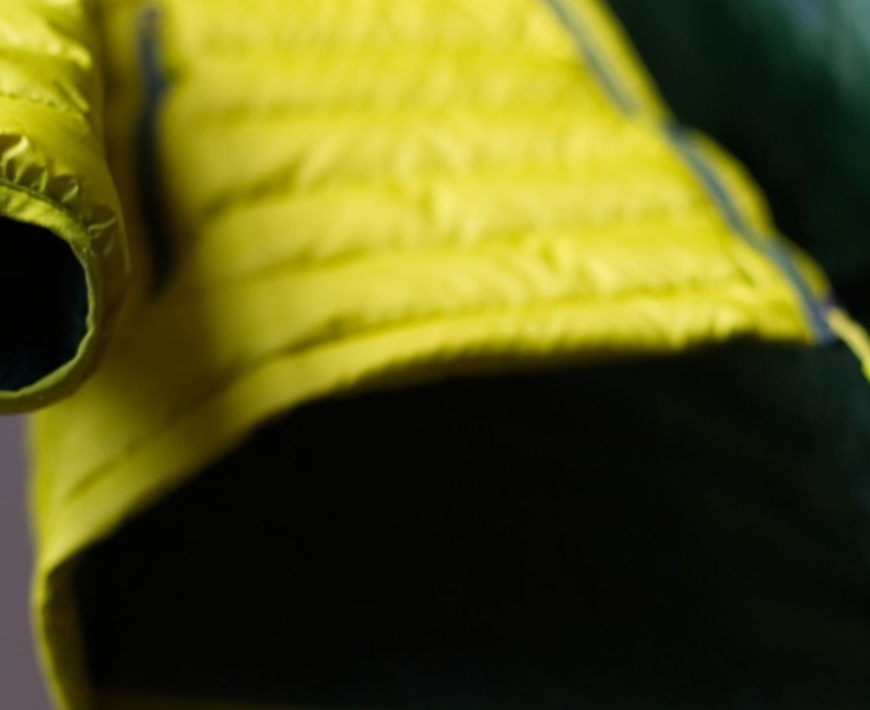
Insulation is a key element of your ski jacket that determines how effectively it keeps you warm in cold and snowy conditions. Choosing the right type and amount of insulation depends on your personal preference, the temperature range you'll be skiing in, and your activity level. Here's a more detailed look at insulation in ski jackets:
Types of Insulation:
Down Insulation: Down is the fluffy layer beneath a bird's feathers, typically from geese or ducks. Down insulation provides excellent warmth-to-weight ratio, meaning it offers exceptional warmth without adding excessive bulk. Down jackets are known for their lightweight feel and compressibility, making them easy to pack and carry. However, one drawback is that down loses its insulating properties when wet, so it's crucial to keep a down jacket dry in wet conditions.
Synthetic Insulation: Synthetic insulation is made from man-made fibers like polyester. It is designed to mimic the insulating properties of down while offering some advantages. Synthetic insulation retains its warmth even when wet, making it a more versatile choice for unpredictable weather conditions. Synthetic jackets are often less expensive than down jackets and may be a better choice if you anticipate wet or humid skiing environments.
Amount of Insulation:
The amount of insulation in a ski jacket can vary, and jackets are typically categorized as follows:
Non-Insulated: Non-insulated ski jackets are designed for layering. They have little to no built-in insulation and are meant to be worn over thermal layers or other insulating pieces like fleece jackets or vests. These jackets offer versatility as they can be used in various weather conditions by adjusting your layers accordingly.
Light Insulation: Lightly insulated ski jackets have a thin layer of insulation, usually synthetic, to provide some warmth while still allowing for layering underneath. They are ideal for milder conditions or for skiers who generate a lot of body heat.
Midweight Insulation: Jackets with midweight insulation strike a balance between warmth and versatility. They are suitable for most skiers in a wide range of conditions. The insulation provides adequate warmth without being overly bulky.
Heavy Insulation: Ski jackets with heavy insulation are designed for extremely cold conditions. They often feature a thick layer of insulation, typically down, to provide maximum warmth. These jackets are bulkier and may limit mobility but are essential for frigid environments.
Consider your skiing style, local climate, and personal preference when selecting the amount of insulation in your jacket. Keep in mind that layering can also help you adapt to changing weather conditions. For instance, you can wear a non-insulated or lightly insulated jacket on milder days and add extra layers underneath when it gets colder.
Ultimately, the choice between down and synthetic insulation and the amount of insulation should align with your skiing needs and the weather conditions you're likely to encounter on the slopes.
Recommended: The Best Ski Jackets For Men And Women
Layering Compatibility

Layering compatibility in a ski jacket is essential to ensure you stay warm and comfortable throughout your skiing adventure. It refers to the jacket's ability to accommodate multiple layers of clothing underneath while still providing a comfortable fit and unrestricted movement. Here are some key aspects to consider regarding layering compatibility:
Fit and Sizing: When choosing a ski jacket, pay attention to its fit and sizing. You'll want a jacket that provides enough room for layering without being too tight or too loose. A jacket that is too tight can restrict your movement and trap air, reducing its insulating efficiency. On the other hand, an excessively large jacket can lead to cold spots and discomfort. Look for a jacket with a slightly relaxed fit that allows you to add thermal layers and mid-layers comfortably.
Zippers and Closure Systems: Check the jacket's zipper design and closure systems. Full-length front zippers with storm flaps are essential for sealing out cold air and moisture. A two-way zipper can be convenient for allowing extra ventilation or accessing layers beneath without fully unzipping the jacket. Look for high-quality zippers that are easy to operate, even with gloves on.
Cuff Design: The cuffs of the jacket should be adjustable to accommodate different layers of clothing underneath. Hook-and-loop closures or elastic cuffs with thumbholes are common features that help seal out cold air and snow while allowing you to secure your gloves or mittens over the cuffs.
Collar and Neck Gaiter: A high collar with a soft chin guard is essential for protecting your neck and face from cold winds and snow. Some ski jackets come with built-in neck gaiters or balaclavas that can be pulled up over your face when needed. These features add an extra layer of warmth and protection.
Pit Zips and Ventilation: While not directly related to layering compatibility, pit zips and ventilation options are important for regulating your body temperature when you've layered up. Look for a jacket with zippered underarm vents or mesh-lined pockets that allow you to release excess heat and moisture during strenuous activity.
Powder Skirt: A powder skirt or snow skirt at the waist can help keep snow from entering your jacket if you happen to fall in deep powder. Ensure that the powder skirt is adjustable and compatible with various layers underneath.
Mobility and Range of Motion: When trying on a ski jacket, move your arms and shoulders to ensure you have the freedom of movement needed for skiing. A jacket with articulated sleeves and a well-designed cut will allow you to bend, twist, and reach without feeling constricted.
Layering System Considerations: Consider your layering system when choosing a ski jacket. Depending on the weather and temperature, you may need a base layer, mid-layer (such as a fleece or down jacket), and the ski jacket itself. Make sure there is enough space to comfortably fit these layers without compressing them, which can reduce their insulating properties.
Remember that layering compatibility also extends to your other ski clothing, such as pants, gloves, and headwear. A well-thought-out layering system ensures you can adapt to changing weather conditions and maintain your comfort and warmth on the slopes.
Fit
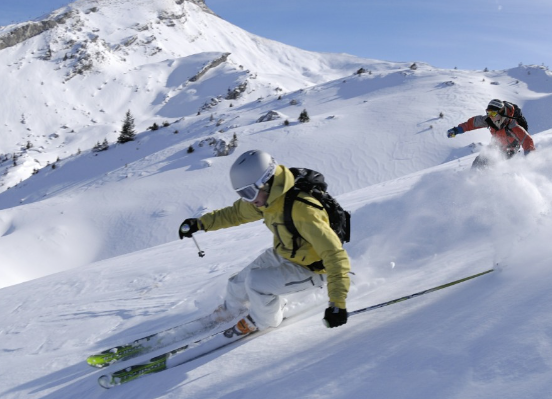
The fit of your ski jacket is a crucial aspect that directly impacts your comfort, mobility, and overall skiing experience. A well-fitting jacket ensures that you stay warm, dry, and agile on the slopes. Here are some important considerations regarding the fit of a ski jacket:
Comfort: Comfort is paramount when choosing a ski jacket. You should feel comfortable and at ease when wearing the jacket, both when you're stationary and during dynamic movements on the slopes. A comfortable fit means you can focus on skiing rather than adjusting your clothing constantly.
Sizing: Ski jackets come in various sizes, typically ranging from XS to XXL or more. It's essential to choose the right size for your body type. Most manufacturers provide sizing charts that help you find the appropriate size based on your measurements. Keep in mind that sizing can vary between brands, so always refer to the specific brand's sizing guide.
Layering Space: As mentioned earlier, layering is crucial for staying warm in cold conditions. A well-fitting ski jacket should have enough room to accommodate thermal base layers, mid-layers (such as fleece or down jackets), and other clothing comfortably. Ensure that the jacket's fit allows for layering without feeling overly tight or restrictive.
Mobility: Your ski jacket should not impede your range of motion. When trying on a jacket, perform movements like reaching your arms forward and overhead, twisting your torso, and bending at the waist. Make sure the jacket allows for these movements without feeling tight or restrictive. Look for jackets with articulated sleeves and a cut that facilitates dynamic skiing motions.
Length: The length of the jacket is a matter of personal preference and can depend on your skiing style. Shorter jackets, often referred to as "waist-length" or "hip-length," provide a more active and streamlined look. Longer jackets, sometimes called "parka-style" or "thigh-length," offer more coverage and can be advantageous in deep powder or colder conditions. Choose a length that suits your style and provides the desired level of protection.
Hood Fit: If your jacket has a hood, ensure that it fits comfortably over your helmet or head. The hood should allow for good visibility and should not obstruct your peripheral vision. Look for jackets with adjustable hoods that can be cinched down to fit snugly during windy or snowy conditions.
Cuffs and Hem: Check the cuffs and hem of the jacket. Adjustable cuffs and hems allow you to customize the fit and seal out cold air and snow. These features are especially important in preventing drafts from entering the sleeves and waist area.
Collar and Neckline: The collar and neckline of the jacket should fit comfortably and not chafe against your skin. A soft chin guard can add extra comfort in this area. The collar should also provide adequate coverage and protection, especially when the jacket is fully zipped.
Try Before You Buy: Whenever possible, try on the ski jacket before purchasing it. Don't hesitate to move around, simulate skiing movements, and check for any discomfort or restrictions in mobility. This hands-on approach will help you assess whether the jacket provides the right fit for your body type and skiing style.
Remember that the right fit may vary from person to person, so what works for one skier may not work for another. Ultimately, choosing a ski jacket with a comfortable, functional, and tailored fit is essential for an enjoyable skiing experience while keeping you protected from the elements.
Recommended: The Best Ski Jackets For Men And Women
Hood
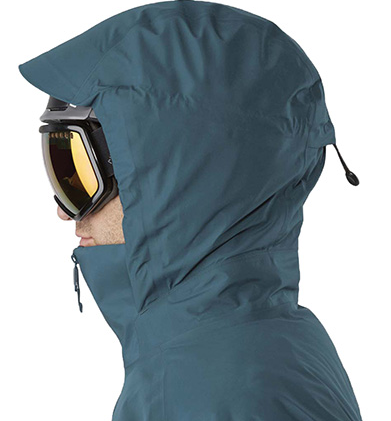
The hood is a crucial component of a ski jacket, offering protection for your head and neck from the elements, especially in adverse weather conditions commonly encountered on the slopes. Here are important considerations when it comes to the hood of a ski jacket:
1. Helmet Compatibility: If you wear a ski or snowboarding helmet, it's essential to ensure that the jacket's hood is helmet-compatible. A helmet-compatible hood is designed to fit over your helmet comfortably without restricting your vision or mobility. It should also provide full coverage around the sides and back of your helmet, shielding your head from wind, snow, and precipitation. Many ski jackets have adjustable hoods with toggles or drawcords that allow you to fine-tune the fit over your helmet.
2. Adjustable Fit: A good ski jacket hood should have multiple points of adjustment to customize the fit. Look for hoods with adjustable drawcords at the front and sides, as well as on the back of the hood. These drawcords enable you to cinch down the hood snugly in windy or stormy conditions, preventing it from blowing off or interfering with your visibility. An adjustable fit also ensures that the hood stays in place during fast descents or sudden movements.
3. Brim and Visor: A brim or visor on the hood is a valuable feature. It helps shield your face from falling snow, rain, or bright sunlight. The brim prevents precipitation from dripping onto your goggles or into your face, enhancing your overall comfort and visibility.
4. Collar Compatibility: When the hood is not in use, it should be designed to lie flat against your back or shoulders without causing discomfort or restricting your movement. Some ski jackets have hoods that can be rolled or stowed away into a dedicated pocket when not needed.
5. High Collar: The hood should connect seamlessly with the collar of the jacket, ensuring full protection for your neck and face. Look for a high collar with a soft chin guard to prevent chafing against your skin. This combination provides added warmth and comfort, especially in cold and windy conditions.
6. Visibility: A well-designed hood should not obstruct your peripheral vision, allowing you to maintain a clear view of your surroundings. It's important to test the hood's fit and adjustability while wearing your ski or snowboarding goggles to ensure they work in harmony.
7. Material and Insulation: The material used for the hood should be both durable and breathable. Some hoods also feature insulation to provide extra warmth for your head. Insulated hoods are particularly beneficial in extremely cold conditions.
8. Versatility: A versatile hood design is adaptable to changing weather conditions. It should provide protection during snowstorms, rain, and wind, as well as offer ventilation options like zippered vents or adjustable flaps for added comfort when necessary.
In summary, a well-designed ski jacket hood should strike a balance between versatility, adjustability, and protection. It should comfortably fit over your helmet, shield your head and neck from the elements, and not hinder your visibility or mobility. When trying on a ski jacket, pay close attention to the hood's features and ensure that it meets your specific needs, whether you're skiing in blustery alpine conditions or enjoying a sunny day on the slopes.
Recommended: The Best Ski Jackets For Men And Women
Pockets

Pockets are an important feature of a ski jacket, providing convenient storage options for essential items and enhancing the overall functionality of the jacket. When choosing a ski jacket, consider the number, type, and placement of pockets to ensure they meet your specific needs. Here's a more detailed exploration of ski jacket pockets:
1. Handwarmer Pockets: These are typically located at chest or waist height and are designed to keep your hands warm during breaks or while waiting in lift lines. Handwarmer pockets are often lined with a soft, insulating material to provide extra warmth. Some may also have zippered closures to secure your belongings.
2. Cargo Pockets: Cargo pockets are larger, roomy pockets often found on the front or sides of the jacket. They are great for storing larger items like gloves, snacks, a map, or even a small water bottle. Cargo pockets usually have Velcro or snap closures for easy access.
3. Pass Pocket: This specialized pocket is designed to hold your ski pass or lift ticket. It's typically located on the sleeve or chest for quick and convenient scanning at ski lifts. Some pass pockets may have clear windows or transparent materials to display your pass without removing it.
4. Interior Pockets: Interior pockets are hidden on the inside of the jacket and are ideal for storing valuables, such as your wallet, phone, or keys. They offer protection from the elements and added security. Look for interior pockets with zipper closures for added peace of mind.
5. Goggle and Electronics Pockets: Some ski jackets come equipped with dedicated pockets for goggles and electronics, like smartphones or music players. These pockets often have soft, scratch-free linings to protect your gear. Goggle pockets may include a lens wipe cloth for cleaning your goggles.
6. Sleeve Pass Pocket: In addition to a pass pocket on the chest or elsewhere, some jackets have an extra pass pocket on the sleeve for added convenience.
7. Mesh Pockets: Mesh pockets are lightweight and breathable, making them suitable for stowing items like gloves, hats, or goggles when they need to air out or dry. These pockets are typically found on the inside of the jacket.
8. Napoleon Pockets: Napoleon pockets are vertically oriented, chest-level pockets that are accessible from the exterior of the jacket. They are excellent for storing small items like lip balm, trail maps, or energy snacks.
9. Exterior Pockets: Some ski jackets have waterproof or water-resistant exterior pockets. These pockets can be handy for items you need quick access to, like a trail map or a ski pass. They help keep your essentials dry in snowy or wet conditions.
10. Ventilation Pockets: While not traditional storage pockets, ventilation pockets are strategically placed openings with zippered closures that allow you to regulate your body temperature by releasing excess heat. These are particularly valuable when skiing in warmer conditions.
When choosing a ski jacket, consider your personal preferences and needs when it comes to pockets. The number and type of pockets you require can depend on factors such as the length of your skiing trips, the gear you carry, and your organizational preferences. Ski jackets with well-placed and thoughtfully designed pockets can make your time on the slopes more convenient and enjoyable.
Gaiters And Cuffs
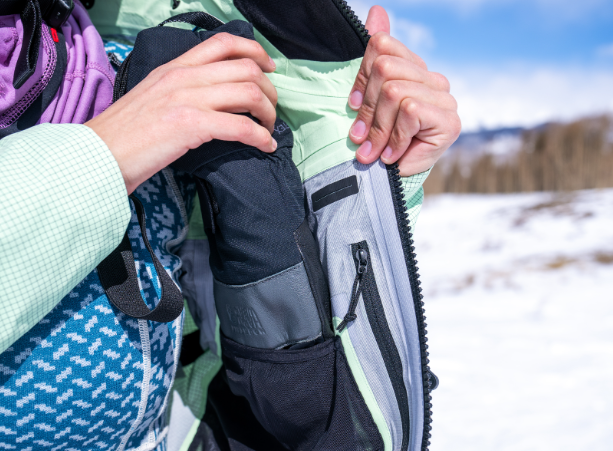
Gaiters and cuffs are essential components of a ski jacket, playing a vital role in keeping you warm, dry, and comfortable while skiing in various conditions. Here's an in-depth look at gaiters and cuffs in ski jackets:
1. Wrist Gaiters:Wrist gaiters are built-in cuffs with thumbholes that extend over your wrists. They serve several important functions:
Sealing Out Cold and Snow: Wrist gaiters create a seal between your jacket sleeves and your gloves or mittens. This prevents cold air, snow, and moisture from entering your sleeves, keeping your hands and wrists warm and dry.
Enhanced Comfort: The snug fit of wrist gaiters keeps your gloves or mittens securely in place, reducing the chances of them slipping off during active skiing or snowboarding. This feature enhances your overall comfort and dexterity.
Additional Layering: Wrist gaiters also aid in layering by allowing you to easily slide your gloves or mittens over them. This minimizes bulk at the junction between your sleeves and handwear.
Convenience: Thumbholes in wrist gaiters provide easy access to your watch or to adjust your gloves without fully removing them.
2. Adjustable Cuffs:Many ski jackets feature cuffs that are adjustable using hook-and-loop closures, snap buttons, or elastic drawcords. These adjustable cuffs serve several purposes:
Customized Fit: Adjustable cuffs allow you to fine-tune the fit of your jacket around your wrists, ensuring a snug and secure seal against cold and snow. They can be tightened or loosened as needed, accommodating different layers of clothing underneath.
Protection from Elements: When tightened, cuffs help seal out wind, snow, and moisture, enhancing the jacket's weatherproofing capabilities.
Versatility: Adjustable cuffs accommodate various glove or mitten styles, making it easy to adapt to changing weather conditions and handwear choices.
3. Powder Skirt:A powder skirt is an additional feature found in many ski jackets, especially those designed for deep powder or backcountry skiing. Here's how it functions:
Snow Protection: A powder skirt is an elasticized or adjustable band located at the waist of the jacket. It serves as a barrier against snow and cold air, preventing them from entering your jacket, even if you take a tumble in deep snow.
Secure Fit: Some powder skirts have snap buttons or attachment loops that can be connected to compatible ski pants or snow bibs, creating a seamless snow-blocking barrier between your upper and lower body.
Versatility: Powder skirts can be tucked away or snapped closed, allowing you to choose whether to use them based on the conditions and your preference.
When selecting a ski jacket, consider your skiing style and the environments you'll be skiing in. If you frequently encounter deep powder or wet conditions, a jacket with wrist gaiters, adjustable cuffs, and a powder skirt can provide enhanced protection and comfort. These features help ensure that your jacket effectively seals out cold, wind, and snow while allowing you to maintain dexterity and enjoy your time on the slopes.
Recommended: The Best Ski Jackets For Men And Women
Durability
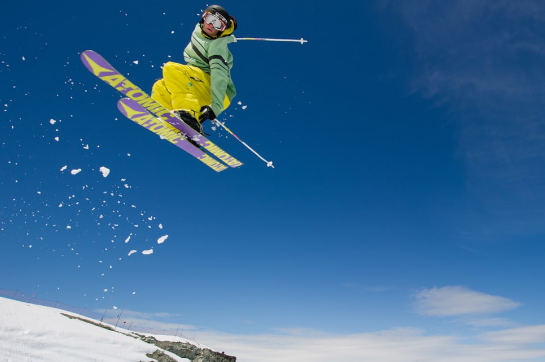
Durability is a critical factor to consider when choosing a ski jacket because skiing often exposes your clothing to a range of demanding conditions, including abrasive snow, ice, tree branches, and equipment wear. A durable ski jacket not only lasts longer but also provides better value for your investment. Here are key aspects to consider regarding the durability of a ski jacket:
1. Material Quality:The choice of materials significantly impacts the durability of a ski jacket. Look for jackets made from high-quality, robust fabrics that are known for their durability. Common materials used in ski jackets include:
Nylon: Nylon is a popular choice due to its strength, resistance to abrasion, and water-repellent properties. Look for jackets with reinforced nylon in high-wear areas like the shoulders, elbows, and cuffs.
Polyester: Polyester is another durable fabric commonly used in ski jackets. It's known for its resistance to stretching, abrasion, and moisture. Some jackets use a blend of nylon and polyester for enhanced durability.
Gore-Tex: Jackets made with Gore-Tex materials are renowned for their durability and waterproofing. Gore-Tex fabrics are engineered to withstand harsh conditions and provide long-lasting performance.
DWR Coating: Many ski jackets have a durable water repellent (DWR) coating applied to the outer layer. This coating helps water bead up and roll off the jacket's surface, preventing saturation and improving overall durability.
2. Reinforcements:Reinforced areas on a ski jacket, such as the shoulders, elbows, and cuffs, are designed to withstand extra wear and tear. They are often made from more durable materials or have additional layers for added protection. Reinforcements can help prolong the life of your jacket, especially if you frequently carry skis or other equipment on your shoulders.
3. Seam Quality:The way seams are constructed and sealed is crucial for both waterproofing and durability. Look for jackets with sealed or taped seams, which prevent water from seeping through the stitching. Reinforced stitching at high-stress points adds to the jacket's longevity.
4. Zippers and Hardware:High-quality zippers and hardware, such as snaps and buttons, are essential for a durable ski jacket. YKK zippers, known for their reliability, are often used in quality ski apparel. Reinforced zipper flaps and storm flaps can further enhance the jacket's longevity by preventing moisture from infiltrating through the zippers.
5. Abrasion Resistance:Consider the abrasion resistance of the jacket's outer material. Skiing can involve brushing against trees, rocks, and other abrasive surfaces, so a jacket with excellent resistance to abrasion is vital for long-lasting durability.
6. Brand Reputation:Research and choose reputable ski apparel brands known for their commitment to quality and durability. Reading reviews and seeking recommendations from fellow skiers can provide insights into the durability of specific jacket models and brands.
7. Care and Maintenance:Proper care and maintenance play a significant role in preserving the durability of your ski jacket. Follow the manufacturer's care instructions, which often include recommendations for washing, drying, and storing the jacket. Regularly reapply DWR coatings as needed to maintain water repellency.
In summary, a durable ski jacket should be constructed from high-quality materials, feature reinforcements in high-wear areas, have well-sealed seams, use reliable zippers and hardware, and offer abrasion resistance. By investing in a durable ski jacket and taking proper care of it, you can ensure that it continues to perform well and protect you from the elements season after season, making your skiing adventures more enjoyable and cost-effective in the long run.
Seams And Zippers
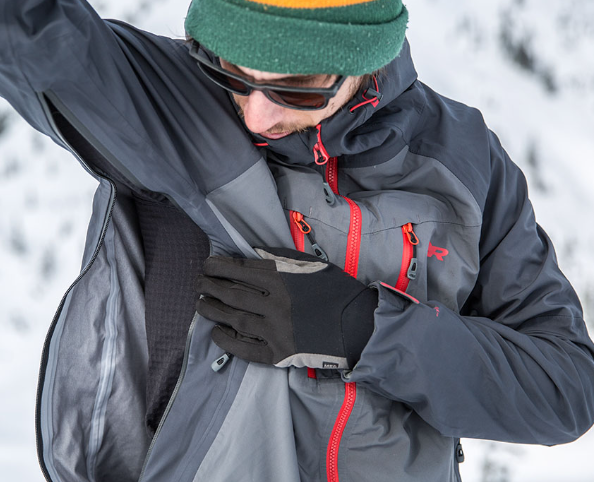
Seams and zippers are essential components of a ski jacket, contributing to its overall functionality, comfort, and durability. Understanding the details of these features can help you make an informed choice when selecting a ski jacket. Here's an in-depth look at seams and zippers in ski jackets:
Seams:
Seam Types:
- Taped Seams: Taped seams are sealed with a waterproof tape on the interior side of the jacket. This tape prevents water from penetrating through the stitched holes in the fabric. Jackets with taped seams offer excellent waterproofing and are ideal for wet and snowy conditions.
- Welded Seams: Some high-end ski jackets use a welding process that fuses the fabric together, creating a seamless, watertight bond. Welded seams are highly effective at preventing water infiltration, and they contribute to the jacket's overall durability.
- Critical vs. Fully Taped Seams: Some jackets have critical seam taping, which means only high-exposure areas like shoulders, chest, and hood have taped seams, while the rest have regular stitched seams. Fully taped seams, on the other hand, cover all seams, providing superior waterproofing.
Reinforced Seams:
- In high-wear areas, such as the shoulders and elbows, ski jackets may feature reinforced seams or extra stitching to enhance durability. These reinforcements prevent premature wear and tear, especially when carrying skis or a backpack.
Stitching Quality:
- The quality of stitching is crucial for the durability of a ski jacket. Look for jackets with strong, reinforced stitching at stress points, like pockets, cuffs, and zippers. Double-stitched seams are often more robust and long-lasting.
Articulated Seams:
- Some ski jackets incorporate articulated seams, which are strategically placed seams that follow the natural contours of the body. These seams enhance mobility and reduce stress on the fabric, improving the jacket's overall lifespan.
Zippers:
Zipper Types:
- YKK Zippers: YKK zippers are renowned for their durability and reliability. Many high-quality ski jackets use YKK zippers for their main closures and pockets.
- Water-Resistant Zippers: Water-resistant zippers have a special coating or design that helps repel water and prevent moisture from entering through the zipper teeth. They are often used on pockets and main closures to enhance waterproofing.
- Two-Way Zippers: Some ski jackets have two-way zippers, allowing you to unzip from both the top and bottom. This feature is handy for ventilation and ease of movement.
Zipper Garage:
- A zipper garage is a fabric or fleece-lined flap at the top of the main zipper that covers the zipper pull. It prevents chafing against the chin or face and keeps the zipper in place. A well-designed zipper garage enhances comfort and prevents damage to the jacket or the zipper.
Storm Flaps:
- Storm flaps are additional layers of fabric that cover the main zipper. They provide extra protection against wind and moisture penetration. Look for jackets with storm flaps secured with Velcro or snap buttons for added weather resistance.
Ventilation Zippers:
- Ventilation zippers are often found under the arms or on the sides of ski jackets. These zippers allow you to regulate your body temperature by releasing excess heat and moisture during strenuous activity. They should be easy to open and close, even with gloves on.
Quality and Ease of Use:
- Check the quality of the zippers and ensure they glide smoothly. Zippers with large, easy-to-grasp pulls are particularly convenient when wearing gloves on the slopes.
When selecting a ski jacket, pay close attention to the seam and zipper features, as they significantly impact the jacket's performance and longevity. High-quality seams and zippers, along with proper care and maintenance, will ensure that your ski jacket remains functional and dependable in a variety of skiing conditions for years to come.
Recommended: The Best Ski Jackets For Men And Women
Wrapping Things Up
In conclusion, choosing the right ski jacket is a multifaceted process that involves careful consideration of various factors. From waterproofing and insulation to fit, pockets, cuffs, seams, and zippers, each element plays a critical role in enhancing your comfort, protection, and overall skiing experience.
A well-chosen ski jacket should not only keep you warm and dry but also provide the versatility and durability needed to withstand the challenges of the mountain environment. Whether you're an avid skier chasing fresh powder or a casual enthusiast enjoying a day on the slopes, the right ski jacket is your trusted companion against the elements.
By prioritizing your specific needs, climate conditions, and personal preferences, you can find a ski jacket that not only meets your functional requirements but also matches your style. In doing so, you'll be ready to tackle the mountain with confidence, knowing that you've made an informed choice in selecting the perfect ski jacket for your winter adventures.
